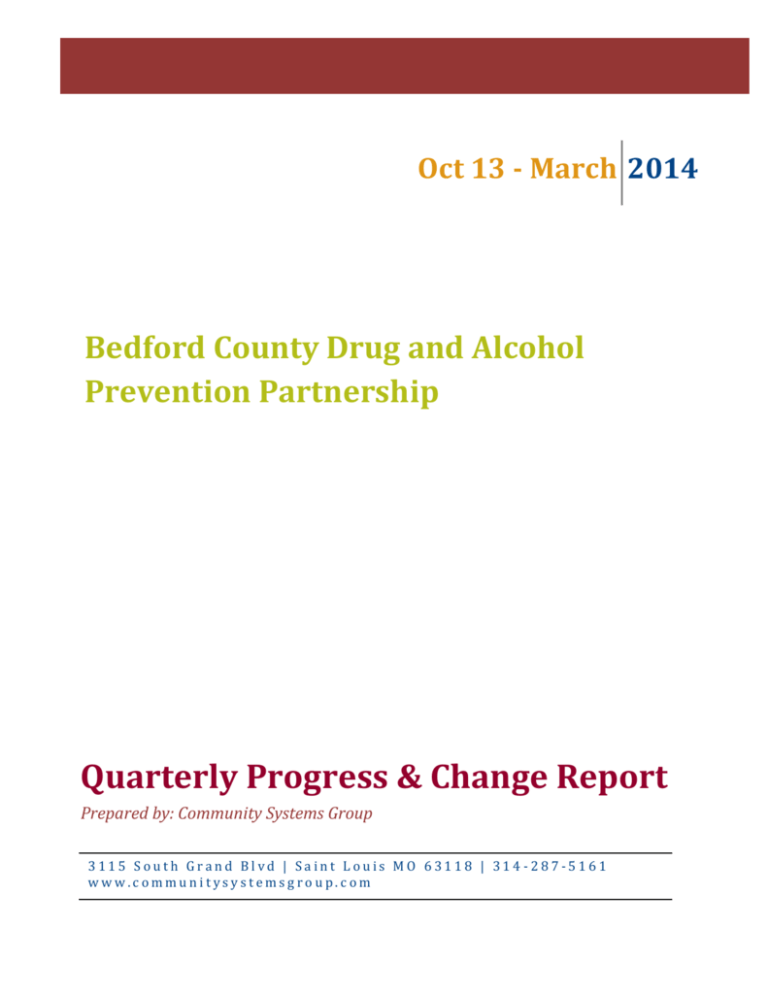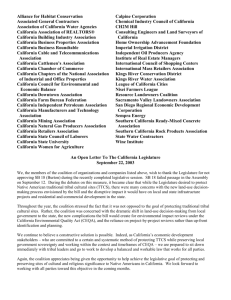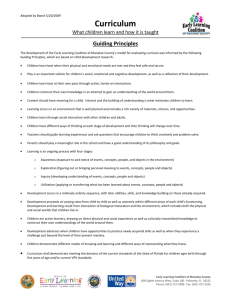BCDAPP Quarterly Report FY13
advertisement

Oct 13 - March 2014 Bedford County Drug and Alcohol Prevention Partnership Quarterly Progress & Change Report Prepared by: Community Systems Group 3115 South Grand Blvd | Saint Louis MO 63118 | 314 -287-5161 www.communitysystemsgroup.com Prepared by Community Systems Group Contents Why is it important to evaluate change? .................................................................................................. 2 What is the definition of change? ............................................................................................................. 2 Coalition Process ........................................................................................................................................... 3 Work with Sectors ......................................................................................................................................... 4 Progress toward Root Causes (But why?) ..................................................................................................... 5 Progress toward addressing Local Conditions (But why here?) ................................................................... 6 Strategic Actions ........................................................................................................................................... 7 Media ............................................................................................................................................................ 8 Pace of Change.............................................................................................................................................. 9 Capacity / Organizational Changes ....................................................................................................... 9 Community Changes ............................................................................................................................. 9 Key Events ............................................................................................................................................. 9 Why is it important to evaluate change? It is the goal of every coalition to create change. Typically, the big goal is to change the community for the better as regards to youth substance abuse (DFC Goal 2). The coalition has proposed to get this job done by getting a group of well-chosen people together to problem-solve what should be done (DFC Goal 1) using a logically chosen set of policies, procedures, and practices that are not currently in place in the community. Outcomes are long-term based on big picture data (ER room reports and student surveys) and intermediate and short term (based on several different data sources). The ODSS and CSG’s protocol help tie these three levels of evaluation, plus the coalition’s problem-solving capacity and process, into a coherent story that aide in accurate discussion of contributions the coalition’s work makes to long-term changes. What is the definition of change? For an activity to be considered Community Change, it must have occurred, include community members outside of the coalition, be related to a goal or objective of the coalition, be a new or modified program, policy, or practice, and be facilitated by individuals who are members of the coalition or are acting on behalf of the coalition. For an activity to be considered Organizational Capacity Change, it must have occurred, include primarily coalition members, have been done in the interest of building the coalition's capacity to address their goals (through membership development, training, TA, targeted outreach, or planning), and involve a coalition process. 2|P a g e Report for October 1, 2013 – March 31, 2014 Prepared by Community Systems Group Coalition Process The process of building a coalition is done in iterative steps that result in cycles of development and stasis – and that vary in intensity of use based on what particular part of the logic model is being addressed. Regardless, the Work Group for Community Health and Development at the University of Kansas developed set of processes (and skills) in which successful coalition’s consistently engage. Developed by KU into the Community Toolbox, Community Anti-Drug Coalitions of America applied the processes to the Strategic Prevention Framework, highlighting the cyclical use of the skills. When using the ODSS, coalitions are asked to put every capacity building activity in which they engage through the lens of “process used.” Are we using known coalition processes to build our coalition's reach and impact? 100% 1 90% 3 80% 2 3 Create/receive and use evaluative feedback Assure effective implementation 70% 3 Create or strengthen resources 60% 1 Position coalition as subject matter expert 50% 3 Define organizational structure and operating mechanisms 40% 2 30% Build coalition membership and leadership Create or update planning products 3 20% 8 Analyze data and research Gather general content or knowledge 10% 0% Capacity Change All Other Capacity Building Activity 3|P a g e Report for October 1, 2013 – March 31, 2014 Prepared by Community Systems Group Work with Sectors Coalitions should be, as rarely as possible, about direct service. Thus, especially in the change category, finding sectors other than “youth” or “parents” that have been addressed is the most ideal situation. It means the coalition is addressing change in “systems,” and other agencies or groups are providing the services to which the change opened the door. Looking at both capacity and community change alongside services gives a coalition an interesting perspective on how changes in system sectors may create or open the door to additional capacity for the community to reach and serve youth, parents, and families. It also provides the most complete look possible at the ways in which a coalition may engage all twelve sectors. Have we engaged all the sectors appropriately? 10 9 8 7 6 5 4 3 2 1 0 Community Changes Capacity Changes Services Provided Comments: At the coalition meeting in January, it was noted that two new members attended. If the particular sector these people represented can be noted, the ODSS and chart can be updated to reflect “capacity changes” in those sectors. Reflection Questions: 1. Are these the sectors where you intended change to occur? If not, what can you do in the next 30 days to begin targeting the intended sectors? 2. Were there sectors you committed to target in your DFC Goal 1 regarding capacity building? Have those sectors shown up here yet? If not, can you anticipate when they will? 3. Is recruitment and action on these targeted and planned or by chance? 4|P a g e Report for October 1, 2013 – March 31, 2014 Prepared by Community Systems Group Progress toward Root Causes (But why?) Anti-drug coalitions typically organize around either the Asset Building or Risk/Protective Factor approaches, or sometimes both. Regardless of specific goal or drug targeted, the narrowing in on causality of the problem using one or both of these science-based frameworks creates or implies a set of actions that may be chosen locally based on further local exploration. In the case of BCDAPP, the Risk and Protective Factor approach serves as the lens through which root causes were selected. Did our community changes address priority risk and protective factors? Other 0% 0% 0% n=4 High Availability 0% Did our services address priority risk and protective factors? n = 13 0% 0% 0% Other 15% Low Perception of Risk 25% Community and Social Norms Favorable 75% Communit y and Social Norms Favorable 39% High Availability 23% Low Perception of Risk 23% 5|P a g e Report for October 1, 2013 – March 31, 2014 Prepared by Community Systems Group Progress toward addressing Local Conditions (But why here?) Local conditions attempt to explain the knowledge, attitudes and beliefs that are driving a community’s root causes. Existing at the most local level and with as much precision as available, local conditions drive the selections of action and activities in which the coalition engages. Local conditions show change and outcomes the most quickly, and are the easiest to measure in terms of outputs. They are frequently difficult to measure in terms of supporting quantitative data, and thus can require – for outcomes purposes – smart application of survey tools and qualitative measures. Adults do Adults What of our community conditionspurchase County Youth are not liquor priority drinking acknowledge addressed local conditions? and/or the risks of establishmen whilendriving provide =4 ts fail to card or riding youth alcohol with drunk tobacco use. properly for youth 0% people. 0% 0% to 0% consume. 0% None selected Alcohol use 25% Students and perceive promotion is higher rates an integral of peer use part of many than is social reported in functions. surveys 0% 75% . Youth Adults Were our services directed at altering are purchase drinking and/or identified local conditions? while County liquor provide n = 13 driving establishmen alcohol for or youth to ts fail do to card Adults not riding consume. properly acknowledge with 0% Youth 0% of the risks drunk attending Students youth people. school drunk perceive tobacco use. 0% rates or high higher 8% 8% of peer use than is reported in surveys 8% Alcohol use and promotion is an integral part of many social functions. 15% None selected 61% 6|P a g e Report for October 1, 2013 – March 31, 2014 Prepared by Community Systems Group Strategic Actions With local conditions identified, the coalition has then chosen a set of strategic actions into which to group their activities. Successful coalitions have a spread of all 7 of the activity types defined by CADCA and required by DFC, and likely use an additional two defined by the Forum for Youth Investment Ready by 21© for creating big picture change – align resources and strengthen constituent voice. Environmental changes show up more frequently at the change level, with the services tending to be more around individual strategies. Thus, it becomes helpful to always look at both change and services for the types of strategic actions in which the coalition engages. What service provision strategies did we use to create community changes? n=4 Physical Design of the Environm ent 0% Strengthe n Constitue Change nt Voice Conseque 25% nces or Incentives Policy Chage 0% 0% Provide Informati Provide on Support 50% 0% Change Access or Barriers 0% Build Skills 25% What service provision Policy strategies didChage we use to 0% provide services? Strengthe nn=13 Physical Constitue Change Design of nt ConsequeVoice the 0% nces or Environm Incentives ent 8% 0% Build Provide Skills Support 23% 15% Change Access or Barriers 0% Provide Informati on 54% 7|P a g e Report for October 1, 2013 – March 31, 2014 Prepared by Community Systems Group Media Interaction with and use of media is always a large component of a coalition’s influence. The following chart represents the kind of media employed each quarter, with the line representing 100% of the instances of media in any given quarter. Thus, observing the instance numbers in the label to discover the total number of instances of media is as important as reconsidering the variety of mediums used, especially over the course of the year. Are we using all forms of media available to us? Other 100% 90% 80% 70% 60% 50% 40% 30% 20% 10% 0% Press Releases Printed Info Mail Internet/Social Media TV Radio Billboard Newspaper Newsletter 4 1 6 3 1 1 Q1 Date 1/13/2014 1/13/2014 1/29/2014 1/29/2014 2/10/2014 2/10/2014 3/3/2014 3/3/2014 3/10/2014 3/10/2014 3/17/2014 3/17/2014 3/25/2014 3/25/2014 Q2 Page BCDAPP Setting the Pace BCDAPP Setting the Pace BCDAPP Setting the Pace BCDAPP Setting the Pace BCDAPP Setting the Pace BCDAPP Setting the Pace BCDAPP Setting the Pace Q3 Q4 New likes Engaged Reached Views 18 31 82 43 236 65 80 52 41 30 85 8|P a g e Report for October 1, 2013 – March 31, 2014 Prepared by Community Systems Group Pace of Change How to read graph: The graph below reports cumulative change where each occurrence of change is added to the previous. As such, flat lines represent periods where no change occurred. Capacity / Organizational Changes What is our pace of change? 45 40 35 30 27 29 31 32 34 36 24 25 20 20 14 13 15 11 2 2 6 Q4 2012 2 5 Q3 2012 5 Q2 2012 10 Q1 2012 9 6 7 8 Q1 2014 Q4 2013 Q3 2013 Q2 2013 Q1 2013 Two new partnership members attended the January coalition meeting. In February, the new Planning Committee began work. The Youth Committee recruited additional members and began work on a middle school “Setting the Pace” newsletter. Community Changes 0 Q4 2011 The purpose of this category is to track changes the coalition makes to its internal structures to better enable its community facing works. Examples include new members, new by-laws, new committee structures, and newly approved action plans. Coalition analysis should include reflection upon the quality of the changes, and which goals were supported by creation of the change. Community changes reflect the coalition’s community facing work. The Facebook page for the "Setting the Pace" social media campaign was Community Change Organizational Change established and published. The song "Choices" was written by a student and will be the theme song of the “Setting the Pace” program. Key Events Quarter Two (January – March 2014) should be understood in relation to the following two things: BCDAPP’s competitive application for DFC funding for Years 6 – 10 was prepared and submitted. An unusually harsh winter meant that people were not able to move about the area very well, meaning meeting attendance was low and some events and plans were cancelled outright. 9|P a g e Report for October 1, 2013 – March 31, 2014





